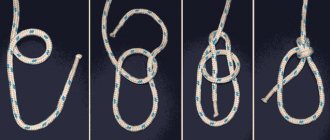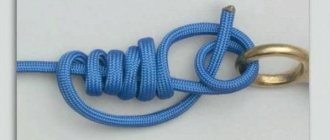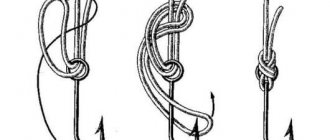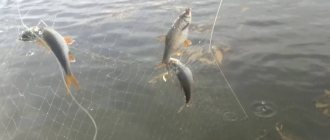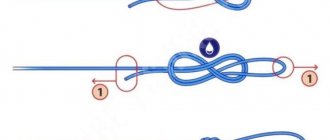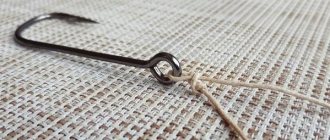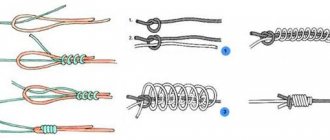Each node has its own characteristics, due to which it is used in the area most suitable for it. The palomar fishing knot is most often used to tie fishing line or cord to a hook or other tackle that has a ring for fastening. Most fishermen know how to tie several dozen knots and can attach gear in different ways, but most often they use the one that has proven its convenience and reliability in practice. That is why palomar is used by both beginners and experienced anglers.
The palomar fishing knot is most often used to tie fishing line or cord to a hook or other tackle that has a ring for fastening
Other types of Palomar knot
There is a diagram that gives an idea of how to knit a simplified “Palomar”. It allows you to save fishing line and is distinguished by the fact that the loop is not passed through the eye of the hook, but is passed through the remaining tip; In this case, you can make several revolutions. This type of fastening is less reliable than the classic one, but is also used by fishermen. It is recommended to try both options before settling on one that is convenient for a particular type of fishing.
This is interesting: Homemade foam boat, how to make a foam boat
Strong connections are important not only for baits. Anchors on boats, tent slings, and climbing mounts also require reliability and simplicity. For these cases, the Palomar was modified into a triple knot. It is no longer suitable for tying hooks - their eye is too small.
Despite its versatility, Palomar has its own characteristics
Sometimes it can be used with small diameter braid and wobblers.
How to knit a triple “Palomar”:
- As in the usual version, the cord is folded in half, forming a loop.
- The twist is passed through the bait ring. The main difference is that the loop passes through the ring 2 more times. With small ear sizes this is not feasible.
- Above the bait, the base of the cord is tied in a loop, creating a simple knot.
- Without tightening the connection, the twist is carried out through the bait or the object being tied to the turns at the end.
- The knot is wetted and then tightened. The remaining end is cut off, leaving only 2-3 mm for reliability.
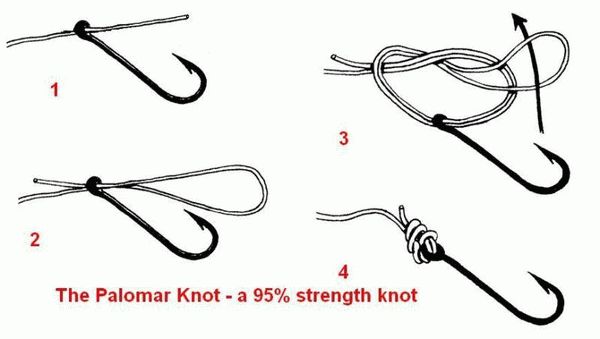
It’s not for nothing that the “Palomar” connection is so widespread among fishermen - with its help you can pull out large fish on the most delicate equipment
The triple connection has one drawback: the turns press on each other, weakening over time.
Pros and cons of the node
The advantages of this type include the following properties:
- Easy knitting: you can master the technique of creating Palomar even without having experience working with knots, so many beginners use this particular variety.
- High reliability: the knot is very durable and can withstand heavy loads, as evidenced by reviews from experienced fishermen. Palomar is suitable for assembling gear intended for catching large sea, river and pond fish.
- Possibility of use for spinning equipment.
However, Palomar also has some disadvantages:
- Large consumption of fishing line during creation.
- Difficulties in tying when the thread is too thick or using hooks and lures with a small eye: some are faced with the fact that the fishing line does not go inside.
- The impossibility of knitting to attach a hook with a spatula: reliable fixation can only be ensured if there is an eye.
Advantages and disadvantages of the Palomar node
Despite its popularity, Palomar has not only advantages, but also disadvantages. Advantages:
- Possibility of weaving equipment in several ways: with a fixed or free hook, which is determined by the type of fishing.
- Ease of manufacture and reliability of the unit.
- Versatility: Palomar is suitable for fishing line, cord or monofilament.

The connection also has disadvantages:
- The eye of the hook must be large, otherwise it will be difficult to thread a loop through it. This somewhat limits the choice of baits used.
It’s not for nothing that the “Palomar” connection is so widespread among fishermen - with its help you can pull out large fish on the most delicate equipment.
Having tried several tying options, the angler will definitely find the most convenient one for himself, and the simplicity of the knot makes it accessible to beginners.
Alternative nodes
In some cases, weaving can be replaced by its closest “relatives”. For example, for laces and braids you can use Uni. To implement it, it is not necessary to use a double thread (Figure 8).

Figure 8. Palomar is excellent for securing gear, but it can be replaced with alternative options
It is perfect for attaching a swivel, a hook with a small diameter fishing line. Another option is the Clinch, its strengths are available in both smooth and woven threads. Here everything is a little simpler, the bunch uses a double loop.
Secrets of the palomar fishing knot
Many anglers dream of catching a trophy that meets their aspirations. For some, the ultimate dream is a kilogram crucian carp, while others dream at night about a two-meter catfish. But you must always be prepared to catch trophy fish. It will be very disappointing when the coveted prey gets lost near the shore or near the boat because of a loose hook. The palomar fishing knot allows you to securely tie a leash, hook or artificial bait. To master the knitting technique, you need to choose the appropriate option and repeat the simplest steps several times.
Double Palomar
The double knitting option is designed for heavy loads, so its modification is a little more complicated. Mainly used when tying braided cord.
Step-by-step instruction:
- Fold the cord in half
- Pass the resulting loop through the ring
- Take the double line and thread it through the loop
- Make a loop around the cord
- Insert a hook into the resulting loop
- After pre-wetting, begin to tighten
- Cut off the excess cord (fishing line)
- That's it, the double Palomar is ready.
Weaknesses of fishing knots
Fishermen have come up with a lot of knots, including both simple knitting patterns and very sophisticated ones. However, the quality of the connection does not always depend on the complexity. It is more important to reduce the number of sharp kinks that weaken the line.
This is interesting: How to fold a tent in a figure eight into a round cover: diagram
Loss of strength most often occurs at the moment of strong tightening of the formed knot. Experienced anglers always moisten the line with water or saliva before final tightening.
Untying of knots can occur for two reasons.
- If the tightening torque is insufficient, the line gradually slips out of the engagement.
- At the last stage, some anglers cut the protruding tip of the line too close to the base of the knot. Under load, the tip of the line slips out of the knot and the connection is untied.
Replaceable units
Palomar is a fairly reliable knot, however, other types can be used to assemble the equipment, which are also easy to knit and withstand jerks well. These include the following types:
- Uni node. This type of knot is suitable for fixing hooks with a small eye diameter and swivels on fishing line. This variety does not require the use of a double thread: you need to thread the tip into the eye, make a loop, wrap the end of the thread around the main line and pass it into the created second loop with several turns. This knot is quite complex and requires experience in tying, but it is quite strong.
- Clinch knot. This variety is suitable for braided thread and classic fishing line. The tip is threaded into the eye, then the main fishing line is wrapped around it for 5-6 turns, the end of the thread is passed into the resulting small loop and pulled through a large loop, after which it is tightened.
- Sliding double knot. This knot is optimal for tying fishing lines of various thicknesses; it is used for fluorocarbon threads. Knitting a double requires skill, so beginners rarely resort to using it.
Regardless of the choice of unit design, it is important to choose the right devices and fasten them according to all the rules, only then can you be confident in the quality of the fishing equipment.
Palomar Unit Specifications
One of the most reliable installations, which maximizes the strength of the fishing line, is the palomar knot. It is recommended to be used not only by respected sports fishermen, but also by manufacturers of fishing lines, braids, artificial baits, etc. Why did fishing enthusiasts love this installation?
- Initially, this type of connection was intended for monofilament threads. However, in practice, many spinning anglers and feeder fans use it to tie baits and equipment to braided cords.
- The use of a palomar knot allows you to maintain the strength of the fishing line up to 80% of its original state.
- The installation is suitable for reliable fastening of hooks, spinners, flies, and various equipment with fishing line of different thicknesses.
- The popularity of palomar has led to the emergence of many modifications. Some anglers, when tying a hook, do not even realize that they are very familiar with palomar.
- An important advantage of this knot is its ease of knitting. Any beginner can easily master several simple movements and techniques.
Palomar - an ultra-reliable unit
Many fishermen believe that there is no difference in which knot to use for the tackle. Both fishing line and braid are perfectly connected by Palomar. It does not slip and perfectly connects almost all types of gear, the main thing is that their diameter is not too large. But still, braids and cords from different manufacturers may differ from each other in the composition of the outer coating, weaving, and type of fibers.
Therefore, serious companies producing gear recommend using a certain unit for their products. More often than others, the operating instructions indicate the Palomar unit, which is considered the strongest and most reliable. Its popularity is confirmed by numerous variations. Many experienced fishermen are confident that this type of fastening can only be used for braided lines. But this is a mistaken opinion. The Palomar fishing knot is universal .
Application
Due to its versatility, the palomar knot has found application in various types of fishing. It fits perfectly into any gear.
- The installation securely connects the fishing line or braid with spinning baits and flies.
- Supporters of the float rod use a knot to mount leashes and hooks.
- Spinning fishermen and bottom fishers connect the fishing line with a swivel or carabiner. The knot is suitable for attaching a sinker with an eye.
- Thanks to this knot, it is possible to create new options for equipment.
How to knit
Although the palomar knot is used for mounting various fishing accessories, we will consider the scheme for tying it using the example of a swivel. I think this will be much better and clearer for beginners and experienced fishermen.
The knot is tied on a double fishing line, so when you leave the free end of the fishing line you need to correctly calculate the length and leave a reserve of fishing line or braid
. Leave the working end with the expectation that one knot will require approximately 15 centimeters of fishing line.
Measure about 15 centimeters from the working end of the fishing line and fold it in half. Now you need to insert the double end through the eye of the swivel (bait, cable or hook), as in the diagram below.
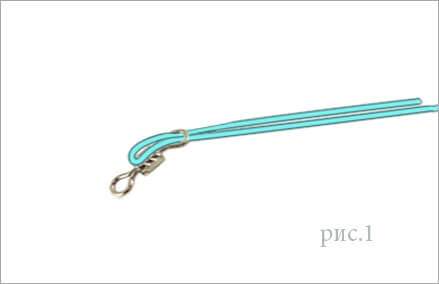
The disadvantage of such a knot is that it will be difficult to thread the double end through a thin eyelet. If this is the case, you can try pulling the single end through the eyelet and then pulling it back through. Ultimately, you should achieve the same result.
Now tie a classic single knot in such a way that the swivel can move inside it, as shown in the picture below.
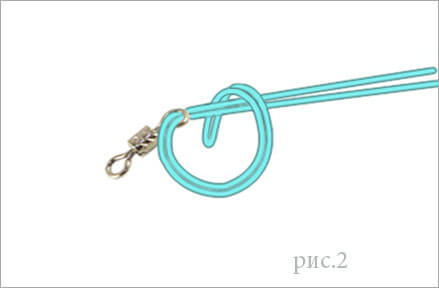
Now comes the hard part. You need to pull out the double end so that you do not overtighten the weave. Now open the double end to make a loop and pull the swivel through it, as shown in the photo.
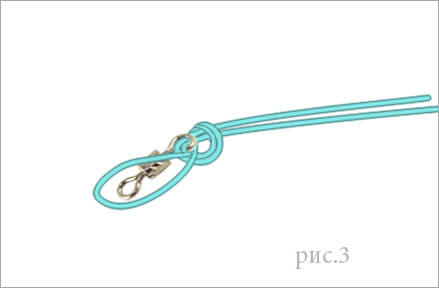
If you are tying a large bait, then the loop must be of the appropriate diameter.
Now you need to wet the knot and tighten it. You need to tighten it smoothly and pull both wires at the same time, and give them the same load.
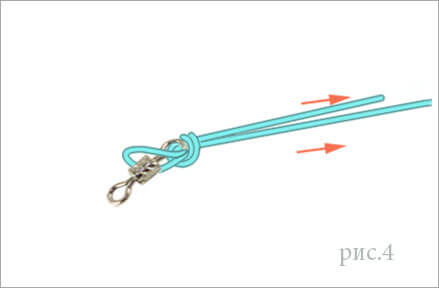
Now that the loop has passed through the eye, you need to tighten the knot more. It is best to do this with both hands, holding the swivel in one and the fishing line in the other. Now you need to cut off the excess fishing line, leaving about 3 millimeters.
When you tighten the knot, the loop may get caught on uneven surfaces, in which case you can push it with your hands. Make sure that the loop is not tightened prematurely, otherwise it will interfere with the movement of the entire equipment.
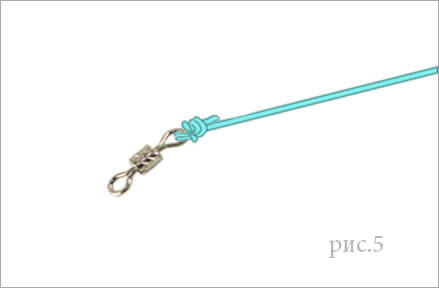
How to make a knot
Before learning how to tie a palomar knot, it is important to choose the most suitable modification for each specific case. There are several proven varieties of the knot. How do they fit together?
Classic Palomar
To tie a hook or spinning lures to a fishing line, the classic version of palomar is used.
- The resulting loop should pass through the eye of the hook or spoon.
- Holding the formed loop with two fingers, you need to make a regular knot.
- Then insert the hook inside the elongated loop.
- Now all that remains is to tighten the knot by pulling both ends of the fishing line. The connection is moistened before final tightening. The end of the fishing line is cut to a length of 3 mm.
This is interesting: What to do if you are caught in an avalanche (action algorithm)
Double palomar
An improved modification of the classic version is the double palomar knot. It is somewhat more difficult to knit, but it produces a durable connection for slippery braided lines.
- The loop is passed through the ring of the hook, swivel or bait.
- The loop is wound behind the double fishing line and inserted into the resulting loop. Now another loop is made around the double cord.
- A hook, swivel or bait is inserted into the elongated loop.
- The scaffold structure is moistened with water or saliva and tightened.
- The excess piece of braiding is cut off.
Triple palomar
Another type of palomar is designed for mounting baits and accessories with a large eye to the braided line. Tying a hook with such a knot is problematic due to the fact that you need to pass a single cord through the ring 6 times. It is not recommended to use a triple knot for monofilament lines.
- The initial stage of node formation is similar to previous versions. The braid, folded in half, is pulled into the bait ring. After this, you need to pass the loop through the eye two more times.
- All that remains is to make a regular knot above the bait, pass the bait into the elongated loop and tighten the connection.
Palomar for drop shot
One of the popular spaced rigs among spinning anglers has recently become the drop shot. A distinctive feature of the rig is the end sinker tied to the main line and the hook located directly on the line above the load. The hook must be tied to the base in such a way that it is fixed with the tip facing up. To achieve this position, the formation of a node begins according to the classical scheme.
- After pulling the loop into the ring of the hook, a regular knot is made opposite the fore-end. This small improvement allows you to firmly fix the hook so that it does not change its position during the fishing process.
- Then the hook is inserted into the loop, the structure is wetted and tightened.
Classic Palomar
How to tie a Palomar knot? The classic version is performed according to the following scheme:
- take the end of a fishing line 20–30 cm long and fold it in half;
- the resulting loop should pass through the eye of the spoon or hook;
- you need to take the loop with two fingers and make an ordinary knot;
- after this you need to insert the hook inside the elongated loop.
Then all that remains is to tighten the knot by pulling the ends of the fishing line. Before it is finally tightened, the connection is moistened. The ends of the fishing line are cut to leave 3 mm.
Fluorocarbon knots
Fluorocarbon lines are much tougher than regular nylon lines and braided lines. They hold the load on the knot less well, and due to their elasticity, they tighten very poorly. The thicker the fluorocarbon line, the more difficult it is to tie a knot or tie it to another line.
To tie hooks or lures to thin fluorocarbon fishing line, you can use the Uni knot (Grinner) and the other knots listed above, making them with a large number of turns.
To tie fluorocarbon to another type of fishing line, use the Carrot Knot and Albright knot. The Carrot knot can be used to tie very thick fluorocarbon. These nodes were also shown above.
To tie a bait, snap hook or swivel to a fluorocarbon line through a loop, use a Rapala knot.
Rapala
The Rapala knot is good because it forms a strong, non-tightening loop on which the bait is freely suspended. Indispensable for attaching wobblers directly to the fishing line. The Rapala knot is also used to make fluorocarbon leaders.
How to tie a Rapala knot:
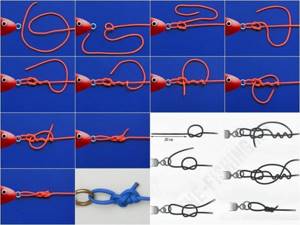
Rapala knot
Double Palomar - an even more complicated and stronger version of the popular knot
How to knit it? Here's the explanation:
- You will also need double fishing line. Therefore, either pass the double loop through the eye of the bait (hook), or back and forth, if it is more convenient to thread the single end.
- With the free end, make a loop on the main core, and then several turns inside it.
- Just as with regular Palomar, pull the end of the fishing line as far as necessary to further tie the knot.
- Throw a loop over the bait, wet the line and pull on the main core and free end. The knot will tighten. Cut off the resulting long end.
Tip: For cutting fishing line, it is best to have special wire cutters in your fishing box, not scissors. Or at least an accessory from a manicure set. They are much easier to use than scissors.
Palomar is all-season. Remember the Palomar tying pattern. She will help you out more than once while fishing, and perhaps in everyday life.
